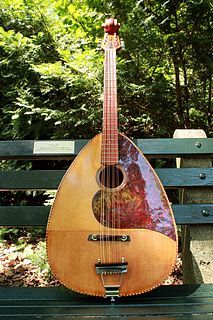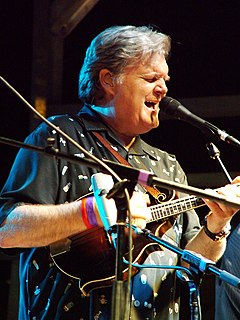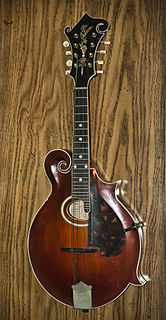The banjo is a stringed instrument with a thin membrane stretched over a frame or cavity to form a resonator. The membrane is typically circular, and usually made of plastic, or occasionally animal skin. Early forms of the instrument were fashioned by African-Americans in the United States. The banjo is frequently associated with folk and country music, and has also been used in some rock, pop and hip-hop. Several rock bands, such as the Eagles, Led Zeppelin, and The Allman Brothers, have used the five-string banjo in some of their songs. Historically, the banjo occupied a central place in Black American traditional music and the folk culture of rural whites before entering the mainstream via the minstrel shows of the 19th century. Along with the fiddle, the banjo is a mainstay of American styles of music, such as Bluegrass and old-time music. It is also very frequently used in traditional ("trad") jazz. Banjo is also a common instrument for Caribbean genres like Biguine, Calypso and Mento.

A mandolin is a stringed musical instrument in the lute family and is generally plucked with a plectrum. It most commonly has four courses of doubled metal strings tuned in unison, thus giving a total of 8 strings, although five and six course versions also exist. The courses are typically tuned in an interval of perfect fifths, with the same tuning as a violin. Also, like the violin, it is the soprano member of a family that includes the mandola, octave mandolin, mandocello and mandobass.

William Smith Monroe was an American mandolinist, singer, and songwriter, who created the bluegrass music genre. Because of this, he is often called the "Father of Bluegrass".
Bluegrass music is a genre of American roots music that developed in the 1940s in the United States Appalachian region. The genre derives its name from the band Bill Monroe and the Blue Grass Boys. Unlike mainstream country music, bluegrass is traditionally played on acoustic stringed instruments. Bluegrass has roots in traditional English, Scottish, and Irish ballads and dance tunes and in traditional African-American blues and jazz. Bluegrass was further developed by musicians who played with Monroe, including 5-string banjo player Earl Scruggs and guitarist Lester Flatt. Monroe characterized the genre as: "Scottish bagpipes and ole-time fiddlin'. It's a part of Methodist, Holiness and Baptist traditions. It's blues and jazz, and it has a high lonesome sound."
Lester Raymond Flatt was an American bluegrass guitarist and mandolinist, best known for his collaboration with banjo picker Earl Scruggs in The Foggy Mountain Boys.

Earl Eugene Scruggs was an American musician noted for popularizing a three-finger banjo picking style, now called "Scruggs style", which is a defining characteristic of bluegrass music. His three-finger style of playing was radically different from the traditional way the five-string banjo had previously been played. This new style of playing became popular and elevated the banjo from its previous role as a background rhythm instrument to featured solo status. He popularized the instrument across several genres of music.

Ralph Edmund Stanley was an American bluegrass artist, known for his distinctive singing and banjo playing. Stanley began playing music in 1946, originally with his older brother Carter Stanley as part of The Stanley Brothers, and most often as the leader of his band, The Clinch Mountain Boys. He was also known as Dr. Ralph Stanley.

Lloyd Allayre Loar (1886–1943) was an American musician, instrument designer and sound engineer. He is best known for his design work with the Gibson Mandolin-Guitar Mfg. Co. Ltd. in the early 20th century, including the F-5 model mandolin and L-5 guitar. In his later years he worked on electric amplification of stringed instruments, and demonstrated them around the country. One example, played in public in 1938 was an electric viola that used electric coils beneath the bridge, with no back, able to "drown out the loudest trumpet."

James Henry Martin was an American bluegrass musician, known as the "King of Bluegrass".

The mandocello is a plucked string instrument of the mandolin family. It is larger than the mandolin, and is the baritone instrument of the mandolin family. Its eight strings are in four paired courses, with the strings in each course tuned in unison. Overall tuning of the courses is in fifths like a mandolin, but beginning on bass C (C2). It can be described as being to the mandolin what the cello is to the violin.
Flatt and Scruggs and the Foggy Mountain Boys was an American bluegrass band. The band was founded by guitarist Lester Flatt and banjo player Earl Scruggs and is viewed by music historians as one of the premier bluegrass groups in the history of the genre. The band was originally formed in 1948 by Flatt, who had been a member of Bill Monroe's bluegrass band. Flatt brought Scruggs with him shortly after leaving Monroe.
Czech Bluegrass is Czech interpretations of bluegrass music that emerged during the middle of the twentieth century in the southeastern United States.
Clyde Moody, also known as the "Hillbilly Waltz King" and sometimes as "The Genial Gentleman of Country Music" was one of the great founders of American Bluegrass music.

Kenneth Clayton Baker was an American fiddle player best known for his 25-year tenure with Bill Monroe and his group The Blue Grass Boys.

Rickie Lee Skaggs, known professionally as Ricky Skaggs, is an American neotraditional country and bluegrass singer, musician, producer, and composer. He primarily plays mandolin; however, he also plays fiddle, guitar, mandocaster, and banjo.

Collings Guitars is an Austin, Texas based stringed instrument manufacturer. The company was founded in 1973 by Bill Collings who in 2008 was called "one of the most recognized and respected names amongst aficionados of modern acoustic instruments". Their acoustic guitars have been highly regarded for decades. In addition to acoustic guitars they also make electric guitars, archtop guitars, mandolins, and ukuleles.

Bluegrass mandolin is a style of mandolin playing most commonly heard in bluegrass bands.

The mandolin has had a place in North American culture since the 1880s, when a "mandolin craze" began. The continent was a land of immigrants, including Italian immigrants, some of whom brought their mandolins with them. In spite of the mandolin having arrived in America, it was not in the cultural consciousness until after 1880 when the Spanish Students arrived on their international performing tour. Afterwards, a "mandolin craze" swept the United States, with large numbers of young people taking up the instrument and teachers such as Samuel Siegel touring the United States. The fad died out after World War I, but enough had learned the instrument that it remained. The mandolin found a new surge with the music of Bill Monroe; the Gibson F-5 mandolin he played, as well as other archtop instruments, became the American standard for mandolins. Bowlback mandolins were displaced. The instrument has been taken up in blues, bluegrass, jug-band music, country, rock, punk and other genres of music. While not as popular as the guitar, it is widespread across the country.












